Design Research Insights on Text Mining Analysis: Establishing the Most Used and Trends in Keywords of Design Research Journals
Abstract
1. Introduction
2. Design Research
2.1. Design Research Dimensions
2.2. Research Methods Conducted in the Design
3. Research Methodology
- RQ1: What are the major design research topics observed in the dataset?
- RQ2: What changes in design studies were observed during the sample period from January 2007 to March 2019?
- RQ3: What are the vital design research topics that determine the direction of future research?
4. Data Analysis and Discussion
4.1. Descriptive Analysis
4.2. Text Mining Analysis (Clustering)
4.3. Clustering Results
- Co-creation: for instance, that work is related to design thinking, innovation, creativity, design process, and design.
- Co-innovation: increasing the number in design research fields is a hot topic, and it seems very motivating as it appeared in three periods with a greater concern on collaborative design.
- Ethical design: offer new insights/knowledge about the design process within design research.
- Social practice design: it is essential to associate terms that focus on its adoption and other elements affecting the area—research related to participatory design, collaboration, sustainability, design innovation, and articulating design.
4.4. Word Frequency Distribution
5. Conclusions
5.1. Contributions
5.2. Limitations
Supplementary Materials
Author Contributions
Funding
Data Availability Statement
Conflicts of Interest
Appendix A. The Most Popular Terms
| Term | 2007–2011 | 2012–2015 | 2016–2019 |
|---|---|---|---|
| creativity | 47 | 48 | 68 |
| product design | 35 | 39 | 48 |
| design process | 31 | 35 | 49 |
| design education | 30 | 52 | 97 |
| collaborative design | 29 | 23 | 27 |
| design | 24 | 40 | 117 |
| conceptual design | 26 | 32 | 20 |
| collaborative design | 23 | 25 | 25 |
| technology education | 26 | 25 | 15 |
| engineering design | 29 | 30 | 48 |
| innovation | 17 | 19 | 26 |
| design cognition | 19 | 23 | 28 |
| design theory | 16 | 32 | 12 |
| industrial design | 16 | 18 | 12 |
| communication | 14 | 10 | 30 |
| design practice | 0 | 17 | 18 |
| problem solving | 13 | 0 | 0 |
| aesthetics | 13 | 10 | 21 |
| interaction design | 13 | 13 | 21 |
| product development | 12 | 10 | 0 |
| case study | 12 | 18 | 0 |
| design methods | 11 | 15 | 23 |
| architectural design | 11 | 15 | 0 |
| evaluation | 11 | 12 | 16 |
| design activity | 11 | 17 | 0 |
| creative design | 10 | 0 | 0 |
| teamwork | 10 | 3 | 0 |
| service design | 9 | 9 | 43 |
| technological literacy | 9 | 0 | 0 |
| research methods | 9 | 10 | 10 |
| design tools | 9 | 11 | 24 |
| design research | 9 | 16 | 54 |
| participatory design | 9 | 18 | 59 |
| design methodology | 8 | 8 | 0 |
| collaboration | 8 | 14 | 32 |
| curriculum | 8 | 9 | 0 |
| sustainability design | 8 | 10 | 51 |
| interface design | 8 | 0 | 0 |
| learning | 7 | 0 | 18 |
| technology | 7 | 0 | 19 |
| architecture | 7 | 0 | 0 |
| culture | 7 | 0 | 0 |
| design strategy | 7 | 7 | 0 |
| graphic design | 7 | 0 | 0 |
| emotion | 7 | 0 | 0 |
| perception | 7 | 8 | 0 |
| philosophy of design | 7 | 8 | 0 |
| user participation | 7 | 0 | 0 |
| product experience | 7 | 0 | 0 |
| healthcare | 0 | 0 | 25 |
| interdisciplinary | 0 | 0 | 21 |
| craft | 0 | 0 | 22 |
| design fiction | 0 | 0 | 21 |
| circular economy | 0 | 0 | 20 |
| design management | 0 | 17 | 18 |
| usability design | 0 | 0 | 17 |
| user-centered design | 0 | 0 | 17 |
| speculative design | 0 | 0 | 17 |
| participation | 0 | 0 | 17 |
| social design | 0 | 0 | 16 |
| decision making | 0 | 0 | 16 |
| product development | 0 | 0 | 10 |
| inclusive design | 0 | 0 | 8 |
| epistemology | 0 | 0 | 8 |
| art education | 0 | 11 | 16 |
| empathy | 0 | 0 | 16 |
| pedagogy | 0 | 0 | 16 |
| epistemology | 0 | 0 | 8 |
| co-innovation | 0 | 3 | 23 |
| ethical design | 0 | 6 | 19 |
| social practice design | 0 | 2 | 21 |
Appendix B. List of Abbreviations
| Abbreviation | Description |
|---|---|
| CAD | computer-aided design |
| ICT | Information and Communication Technology |
| IT | Information technology |
| MDO | Multidisciplinary Design Optimization |
| AM | Additive manufacturing |
| ABSA | The aspect-based sentiment analysis |
| MTMVN | multitask Multiview network |
| SOTA | Most State-Of-The-Art |
| NMT | Neural Machine Translation |
| LRLs | Low-Resource Languages |
| TL | Transfer Learning |
| CDCAT | Cross-Document Coreference Annotation Tool |
| ESCI | Emerging Source Citation Index |
| CSV | excel sheet |
| HTML | Hypertext Markup Language |
| XML | extensible markup language |
| TF-IDF | term frequency-inverse document frequency |
References
- Gemser, G.; de Bont, C. Design-Related and Design-Focused Research: A Study of Publication Patterns in Design Journals. She Ji 2016, 2, 46–58. [Google Scholar] [CrossRef][Green Version]
- Cooper, R. Editorial: Moving design forward. Des. J. 2008, 11, 5–7. [Google Scholar] [CrossRef]
- Atkinson, P. The Design Journal and the Meaning of Design. Des. J. 2017, 20, 1–4. [Google Scholar] [CrossRef]
- Cooper, R. Design Research: Past, Present and Future. Des. J. 2017, 20, 5–11. [Google Scholar] [CrossRef]
- Giacomin, J. What is Design for Meaning? J. Des. Bus. Soc. 2017, 3, 167–190. [Google Scholar] [CrossRef] [PubMed][Green Version]
- Cooper, R. Design Research Comes of Age. Des. J. 1997, 1 (Suppl. 1), 1. [Google Scholar] [CrossRef]
- Ralph, P.; Wand, Y. A proposal for a formal definition of the design concept. In Design Requirements Engineering: A Ten-Year Perspective; Lecture Notes in Business Information Processing; Springer: Berlin/Heidelberg, Germany, 2009; Volume 14, pp. 103–136. [Google Scholar] [CrossRef]
- Cross, N. Developing design as a discipline. J. Eng. Des. 2018, 29, 691–708. [Google Scholar] [CrossRef]
- Overkamp, T.; Blomkvist, J.; Rodrigues, V.; Arvola, M.; Holmlid, S. Resource Integration as a Perspective on Value in Interaction Design. In Proceedings of the 32nd International BCS Human Computer Interaction Conference, Belfast, UK, 4–6 July 2018. [Google Scholar]
- Jain, A.K. Data clustering: 50 years beyond K-means. Pattern Recognit. Lett. 2010, 31, 651–666. [Google Scholar] [CrossRef]
- Cross, N. Designerly ways of knowing Journal Item. Des. Stud. 1982, 3, 221–227. [Google Scholar] [CrossRef]
- Christensen, B.T.; Ball, L.J. Building a discipline: Indicators of expansion, integration and consolidation in design research across four decades. Des. Stud. 2019, 65, 18–34. [Google Scholar] [CrossRef]
- Liedtka, J. Perspective: Linking Design Thinking with Innovation Outcomes through Cognitive Bias Reduction. J. Prod. Innov. Manag. 2015, 32, 925–938. [Google Scholar] [CrossRef]
- Bremner, C.; Rodgers, P. Design Without Discipline. Des. Issues 2013, 29, 4–13. [Google Scholar] [CrossRef]
- Cash, P.J. Developing theory-driven design research. Des. Stud. 2018, 56, 84–119. [Google Scholar] [CrossRef]
- Dorst, K. The core of design thinking and its application. Des. Stud. 2011, 32, 521–532. [Google Scholar] [CrossRef]
- Brown, T. Change by Design: How Design Thinking Transforms Organizations and Inspires Innovation; HarperCollins Publishers: New York, NY, USA, 2009. [Google Scholar]
- Chamberlain, P.; Bonsiepe, G.; Cross, N.; Keller, I.; Frens, J.; Buchanan, R.; Schneider, B. Design Research Now: Essays and Selected Projects; Walter de Gruyter: Berlin, Germany, 2012. [Google Scholar]
- Grudin, J. Interface: An evolving concept. Commun. ACM 1993, 36, 110–119. [Google Scholar] [CrossRef]
- Hirtz, J.; Stone, R.B.; McAdams, D.A.; Szykman, S.; Wood, K.L. A functional basis for engineering design: Reconciling and evolving previous efforts. Res. Eng. Des. 2002, 13, 65–82. [Google Scholar] [CrossRef]
- Johnson, C. Strategic planning for post-disaster temporary housing. Disasters 2007, 31, 435–458. [Google Scholar] [CrossRef]
- Chai, K.H.; Xiao, X. Understanding design research: A bibliometric analysis of Design Studies (1996–2010). Des. Stud. 2012, 33, 24–43. [Google Scholar] [CrossRef]
- Riaz, M.; Breaux, T.; Williams, L. How have we evaluated software pattern application? A systematic mapping study of research design practices. Inf. Softw. Technol. 2015, 65, 14–38. [Google Scholar] [CrossRef]
- Chakrabarti, A. Towards a taxonomy of design research areas. In The future of Design Methodology; Springer: London, UK, 2011; pp. 249–259. [Google Scholar] [CrossRef]
- Caussade, S.; de Dios Ortúzar, J.; Rizzi, L.I.; Hensher, D.A. Assessing the influence of design dimensions on stated choice experiment estimates. Transp. Res. Part B Methodol. 2005, 39, 621–640. [Google Scholar] [CrossRef]
- Fan, Z.; Ge, Y. The Influence of Techno ethics on Industrial Design. MATEC Web Conf. 2018, 167, 01008. [Google Scholar] [CrossRef][Green Version]
- Hernández, R.J.; Cooper, R.; Tether, B.; Murphy, E. Design, the language of innovation: A review of the design studies literature. She Ji J. Des. Econ. Innov. 2018, 4, 249–274. [Google Scholar] [CrossRef]
- Lee, D.; Lee, H. Mapping the Characteristics of Design Research in Social Sciences. Arch. Des. Res. 2019, 32, 39–51. [Google Scholar] [CrossRef]
- Nusir, M.; Tariq, U.; Ahanger, T.A. Engaging Diverse Stakeholders in Interdisciplinary Co-Design Project for Better Service Design. J. Cases Inf. Technol. (JCIT) 2021, 23, 1–29. [Google Scholar] [CrossRef]
- Bentley, R.A. Random Drift Versus Selection in Academic Vocabulary: An Evolutionary Analysis of Published Keywords. 2008. Available online: https://www.ncbi.nlm.nih.gov/pmc/articles/PMC2518107/ (accessed on 13 March 2019).
- Evans, M. Design Thinking: Understanding How Designers Think and Work by Nigel Cross. Des. J. 2012, 15, 141–143. [Google Scholar] [CrossRef]
- Wang, L.H.; Wang, Q.; Zhang, X.; Cai, W.; Sun, X. A bibliometric analysis of anaerobic digestion for methane research during the period 1994–2011. J. Mater. Cycles Waste Manag. 2013, 15, 1–8. [Google Scholar] [CrossRef]
- Yao, X.; Moon, S.K.; Bi, G. Multidisciplinary design optimization to identify additive manufacturing resources in customized product development. J. Comput. Des. Eng. 2017, 4, 131–142. [Google Scholar] [CrossRef][Green Version]
- Nie, B.; Sun, S. Using text mining techniques to identify research trends: A case study of design research. Appl. Sci. 2017, 7, 401. [Google Scholar] [CrossRef]
- Andreasen, M.M. 45 Years with design methodology. J. Eng. Des. 2011, 22, 293–332. [Google Scholar] [CrossRef]
- Johnson, J.; Cook, M. Policy Design: A New Area of Design Research and Practice. In Complex Systems Design and Management; Springer: Cham, Switzerland, 2014; pp. 51–62. [Google Scholar] [CrossRef]
- Kavousi, S.; Miller, P.A.; Alexander, P.A. Modeling metacognition in design thinking and design making. Int. J. Technol. Des. Educ. 2020, 30, 709–735. [Google Scholar] [CrossRef]
- Lloyd, P. From Design Methods to Future-Focused Thinking: 50 years of design research. Des. Stud. 2017, 48, A1–A8. [Google Scholar] [CrossRef]
- Yong, B.; Yang, Y. A multitask multiview neural network for end-to-end aspect-based sentiment analysis. Big Data Min. Anal. 2021, 4, 195–207. [Google Scholar] [CrossRef]
- Maimaiti, M.; Liu, Y.; Luan, H.; Sun, M. Enriching the transfer learning with pre-trained lexicon embedding for low-resource neural machine translation. Tsinghua Sci. Technol. 2022, 27, 150–163. [Google Scholar] [CrossRef]
- Xu, Y.; Xia, B.; Wan, Y.; Zhang, F.; Xu, J.; Ning, H. CDCAT: A multi-language cross-document entity and event coreference annotation tool. Tsinghua Sci. Technol. 2022, 27, 589–598. [Google Scholar] [CrossRef]
- Shen, L.; Liu, Q.; Chen, G.; Ji, S. Text-based price recommendation system for online rental houses. Big Data Min. Anal. 2020, 3, 143–152. [Google Scholar] [CrossRef]
- Sawsan, A.; Jaradat, R. Clarification of research design, research methods, and research methodology: A guide for public administration researchers and practitioners. Teach. Public Adm. 2018, 36, 237–258.–258. [Google Scholar] [CrossRef]
- Hicks, B. The language of collaborative engineering projects. In Proceedings of the 19th International Conference on Engineering Design (ICED13), Seoul, Korea, 19–22 August 2013; pp. 321–330. [Google Scholar] [CrossRef]
- Aggarwal, C.C.; Zhai, C.X. Aggarwal, C.C.; Zhai, C.X. A survey of text clustering algorithms. In Mining Text Data; Springer US.: Boston, MA, USA, 2012; pp. 77–128. [Google Scholar] [CrossRef]
- Bekkerman, R.; El-Yaniv, R.; Winter, Y.; Tishby, N. On feature distributional clustering for text categorization. In Proceedings of the 24th Annual International ACM SIGIR Conference on Research and Development in Information Retrieval, New Orleans, LA, USA, 9–13 September 2001; pp. 146–153. [Google Scholar] [CrossRef]
- Abu-Shanab, E.; Harb, Y. E-government research insights: Text mining analysis. Electron. Commer. Res. Appl. 2019, 38, 100892. [Google Scholar] [CrossRef]
- Bird, S.; Klein, E.; Loper, E. Natural Language Processing with Python. 2009. Available online: https://books.google.com.au/books/about/Natural_Language_Processing_with_Python.html?id=KGIbfiiP1i4C&source=kp_book_description&redir_esc=y (accessed on 19 March 2020).
- Cielen, D.; Meysman, A.; Ali, M. Introducing Data Science: Big Data, Machine Learning, and More, Using Python Tools. 2016. Available online: https://dl.acm.org/citation.cfm?id=3051941 (accessed on 19 March 2020).
- Haddi, E.; Liu, X.; Shi, Y. The role of text pre-processing in sentiment analysis. Procedia Comput. Sci. 2013, 17, 26–32. [Google Scholar] [CrossRef]
- Pham, D.T.; Dimov, S.S.; Nguyen, C.D. Selection of K in K-means clustering. Proc. Inst. Mech. Eng. Part C J. Mech. Eng. Sci. 2005, 219, 103–119. [Google Scholar] [CrossRef]
- Abu-Shanab, E.A.; Abu-Baker, A.N. Using and buying mobile phones in Jordan: Implications for future research and the Development of New Methodology. Technol. Soc. 2014, 38, 103–110. [Google Scholar] [CrossRef]
- Salton, G.; Wong, A.; Yang, C.S. A Vector Space Model for Automatic Indexing. Commun. ACM 1975, 18, 613–620. [Google Scholar] [CrossRef]
- Haug, A. Four dimensions of product designs. J. Des. Res. 2015, 13, 20–35. [Google Scholar] [CrossRef]


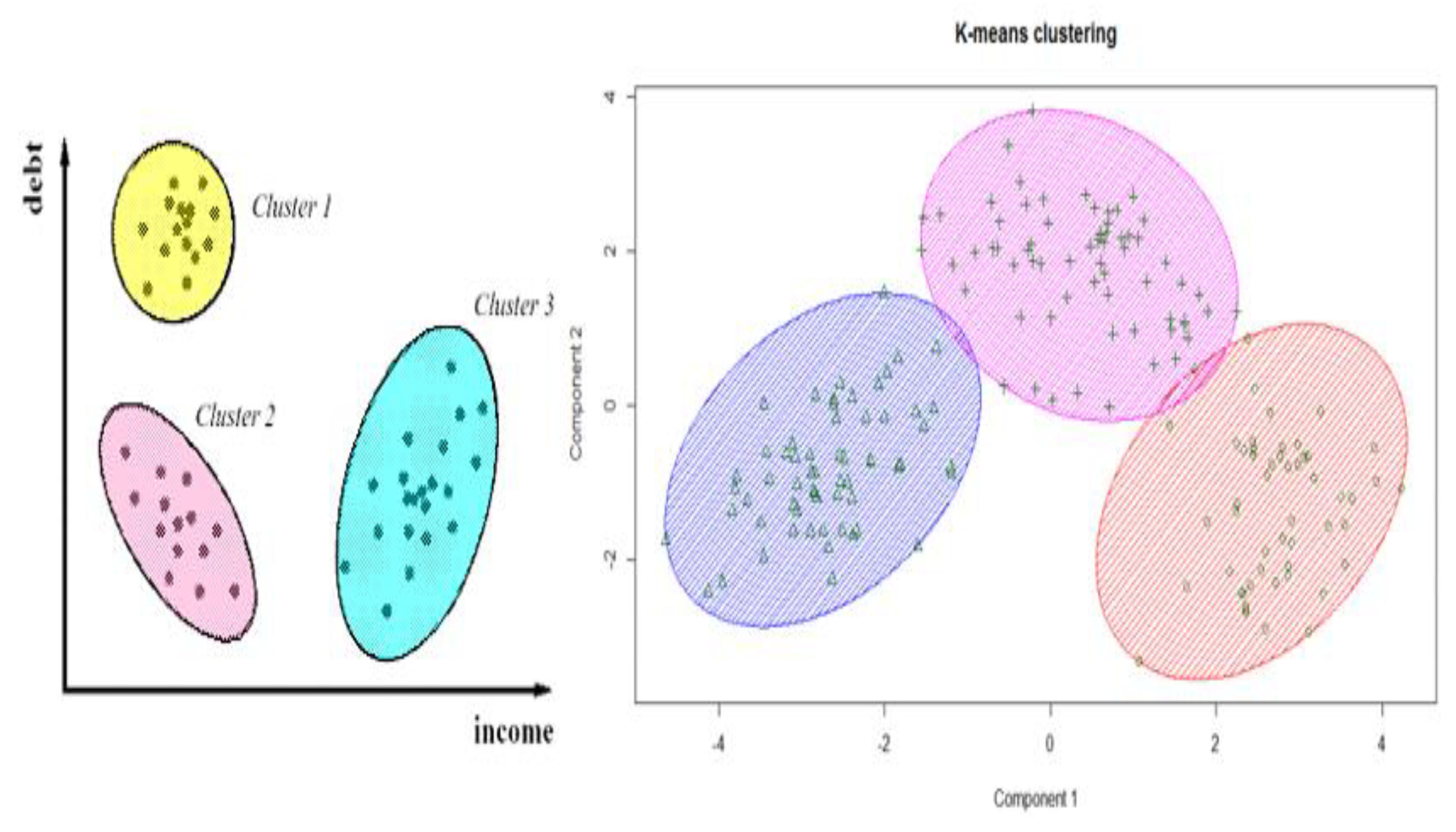

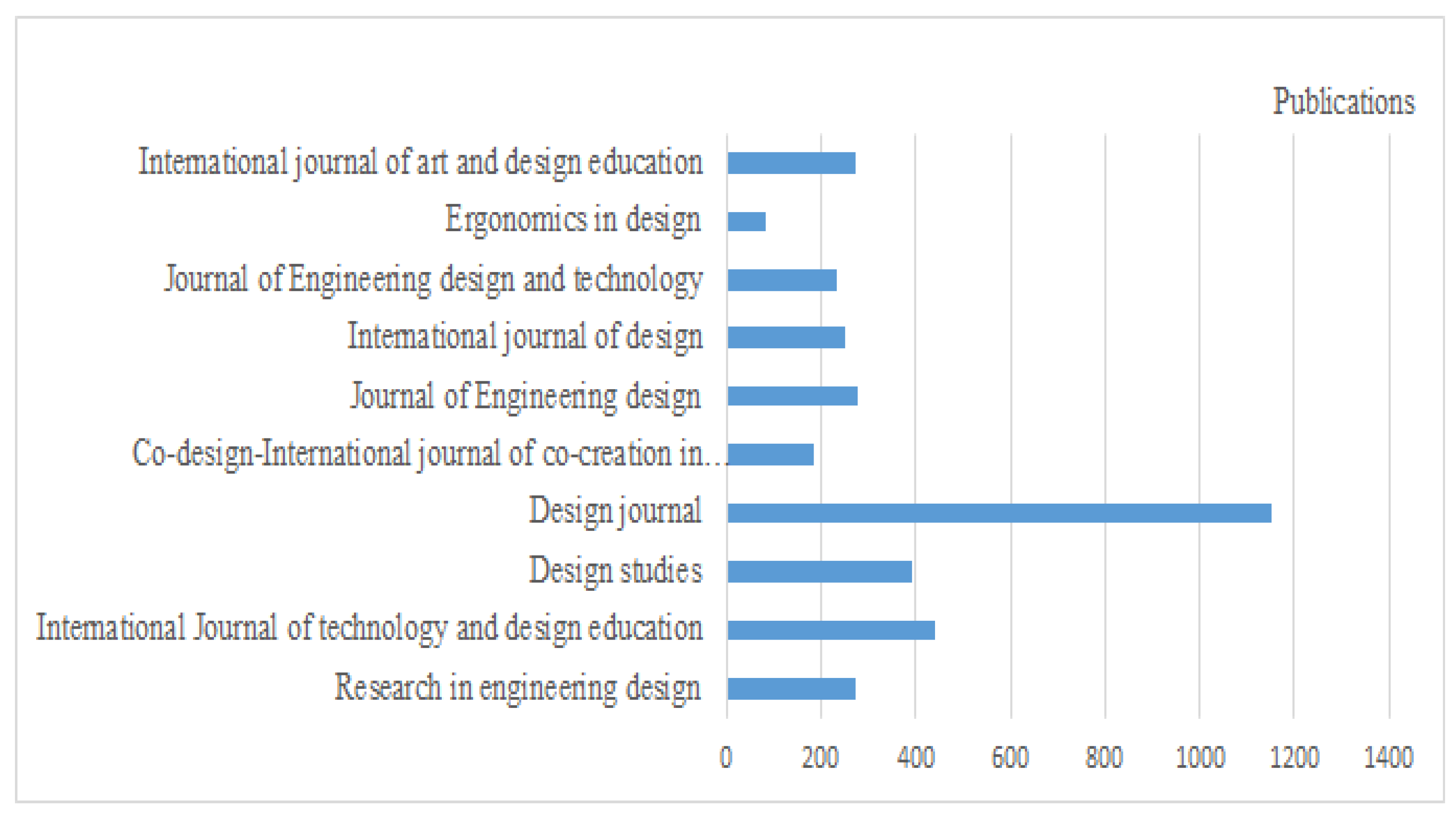
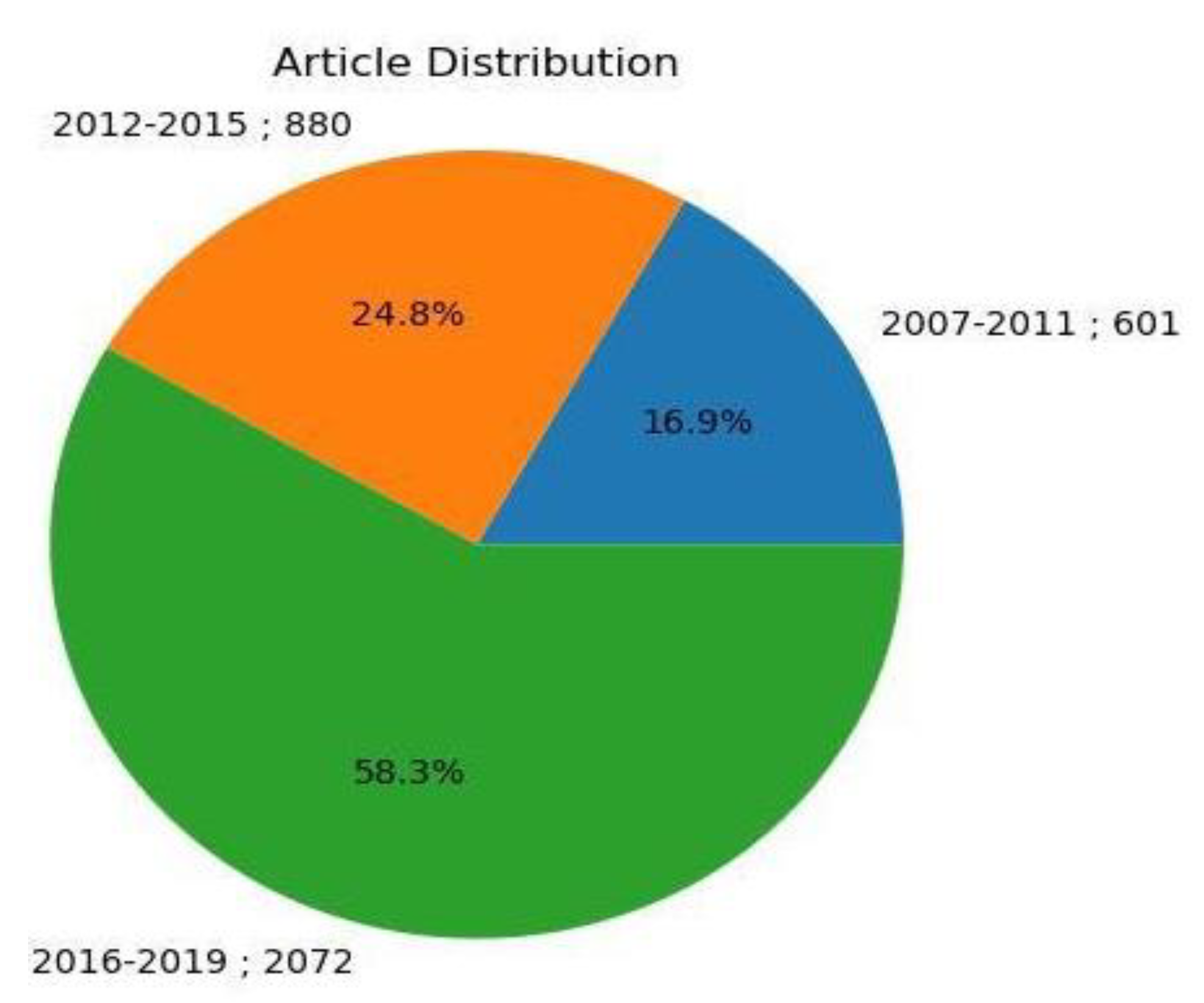



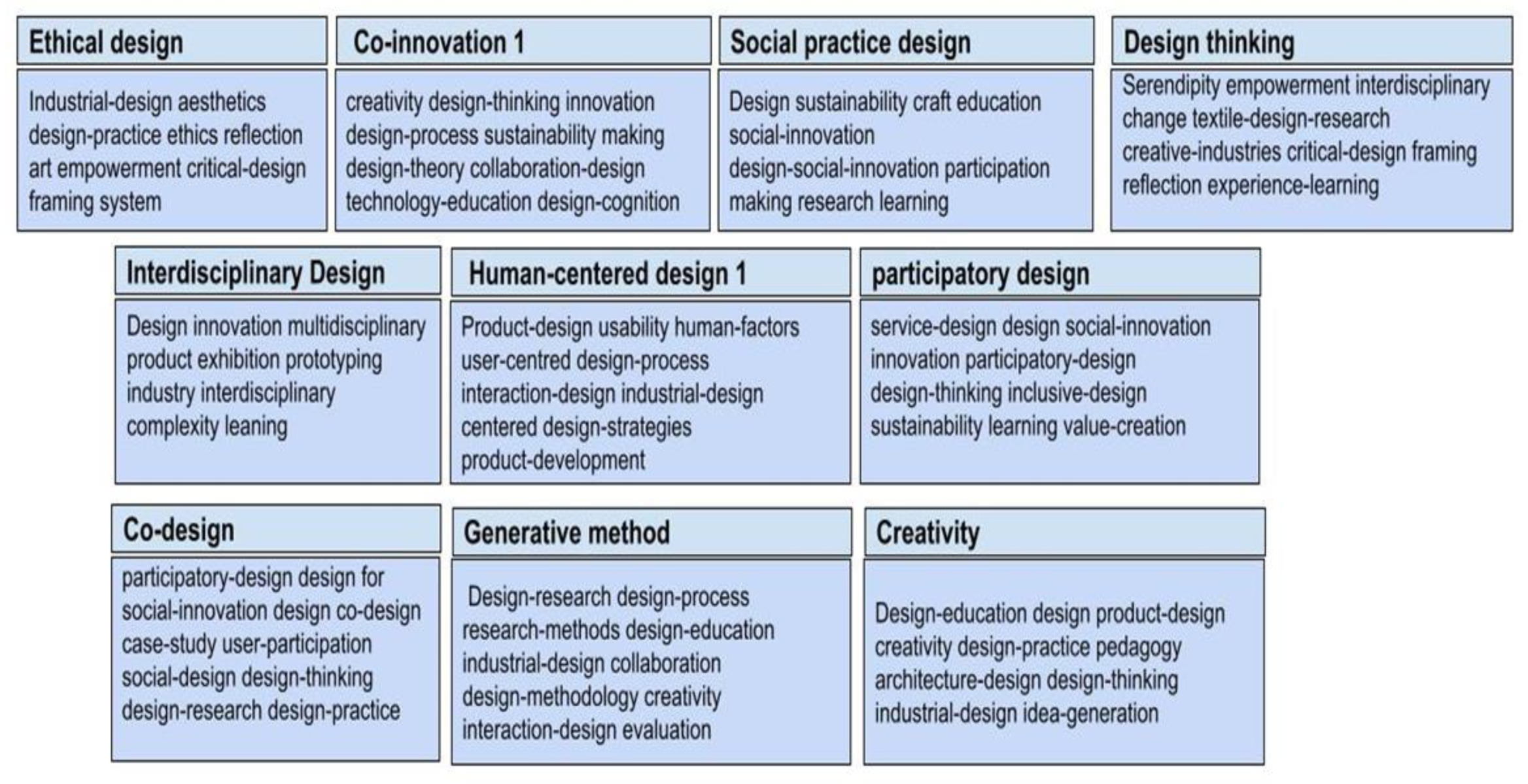
| Code | Journal Name | Total Articles | Total Keywords |
|---|---|---|---|
| 1 | Research in engineering design | 271 | 1315 |
| 2 | International Journal of technology and design education | 441 | 2185 |
| 3 | Design studies | 390 | 1798 |
| 4 | Design journal | 1152 | 5271 |
| 5 | Co-design-International journal of co-creation in design and the arts | 186 | 955 |
| 6 | Journal of Engineering design | 275 | 1288 |
| 7 | International journal of design | 252 | 1218 |
| 8 | Journal of Engineering design and technology | 231 | 1255 |
| 9 | Ergonomics in design | 81 | 677 |
| 10 | International journal of art and design education | 274 | 1524 |
| Keyword | Keyword | Keyword Count |
|---|---|---|
| 0 | Designeducation | 185 |
| 1 | design | 181 |
| 2 | Creativity | 163 |
| 3 | product design | 122 |
| 4 | co-design | 117 |
| 5 | Designprocess | 115 |
| 6 | Participtorydesign | 108 |
| 7 | Innovation | 107 |
| 8 | Designthinking | 97 |
| 9 | Technologyeducation | 87 |
| 10 | Designresearch | 86 |
| 11 | Collaborativeresearch | 79 |
| 12 | Conceptualdesign | 78 |
| 13 | Sustainability | 77 |
| 14 | Designcognition | 74 |
| 15 | Designtheory | 70 |
| 16 | Servicedesign | 69 |
| 17 | Engineeringdesign | 66 |
| 18 | Industrialdesign | 66 |
| 19 | Designpractice | 64 |
| 20 | Interactiondesign | 62 |
| 21 | Collaboration | 58 |
| 22 | Designmethods | 54 |
| 23 | Designtools | 49 |
| 24 | Casestudy | 48 |
| 25 | Education | 45 |
| 26 | Aesthetics | 44 |
| 27 | Communication | 44 |
| 28 | Designactivity | 42 |
| 29 | Evaluation | 42 |
| 30 | Architecturaldesign | 42 |
| 31 | Socialinnovation | 42 |
| 32 | Productdevelopment | 39 |
| 33 | Designknowledge | 37 |
| 34 | Learning | 36 |
| 35 | Pedagogy | 35 |
| 36 | Technology | 35 |
| 37 | Arteducation | 35 |
| 38 | Protocolanalysis | 34 |
| 39 | Designmanegment | 33 |
| 40 | Researchmethods | 33 |
| 41 | Architecture | 32 |
| 42 | Usability | 31 |
| 43 | Participation | 31 |
| 44 | Healthcare | 31 |
| 45 | Designmethodology | 30 |
| 46 | user-centereddesign | 30 |
| 47 | Problemsolving | 29 |
| 48 | Simulation | 28 |
| 49 | Sustainabledesign | 28 |
| Term | 2007–2011 | 2012–2015 | 2016–2019 |
|---|---|---|---|
| 0 creativity | 40 | 48 | 68 |
| 1 product design | 30 | 31 | 48 |
| 2 design process | 27 | 31 | 49 |
| 3 design education | 25 | 49 | 97 |
| 4 collaborative design | 24 | 18 | 27 |
| 5 design | 23 | 40 | 117 |
| 6 conceptual design | 23 | 27 | 20 |
| 7 technology education | 23 | 25 | 25 |
| 8 engineering design | 21 | 19 | 15 |
| 9 innovation | 18 | 24 | 30 |
| 10 design cognition | 17 | 19 | 26 |
| 11 design theory | 16 | 20 | 28 |
| 12 industrial design | 16 | 32 | 12 |
| 13 communication | 14 | 18 | 10 |
| 14 design practice | 14 | 10 | 30 |
| 15 design management | 0 | 17 | 18 |
| 16 problem solving | 13 | 0 | 0 |
| 17 aesthetics | 13 | 10 | 21 |
| Terms | 2007–2011 | 2012–2015 | 2016–2019 | Trend Lines | General Term |
|---|---|---|---|---|---|
| Service design | 9 | 9 | 43 |  | Co-design method and approach |
| Design tools | 9 | 11 | 24 |  | |
| Design research | 9 | 16 | 54 |  | |
| Participatory design | 9 | 18 | 59 |  | |
| Design methodology | 8 | 8 | 0 |  | |
| Collaboration | 8 | 14 | 32 |  | |
| Participation | 0 | 0 | 17 |  | |
| Design graphic | 7 | 0 | 0 |  | Anthropomorphic design |
| Usability design | 0 | 0 | 17 |  | |
| Emotion | 7 | 0 | 0 |  | |
| Perception | 7 | 8 | 0 |  | |
| Interface design | 8 | 0 | 0 |  | |
| Philosophy of design | 7 | 8 | 0 | 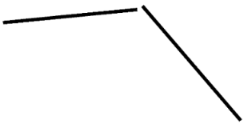 | Assumptions, foundations and implications of design |
| Design fiction | 0 | 0 | 21 |  | |
| Technology design | 7 | 0 | 19 |  | |
| Design strategy | 7 | 7 | 0 |  | Eco-design strategy |
| Sustainability design | 8 | 10 | 51 |  | |
| User participation | 7 | 0 | 0 |  | Co-innovation |
| User-centered design | 0 | 0 | 17 |  | |
| Co-innovation | 0 | 3 | 23 |  | |
| Product experience | 7 | 0 | 0 |  | Co-production |
| Product development | 0 | 0 | 10 |  | |
| Design management | 0 | 17 | 18 |  | |
| Ethical design | 0 | 6 | 19 |  | Social-practice design |
| Inclusive design | 0 | 0 | 8 |  | |
| Speculative design | 0 | 0 | 17 |  | |
| Social design | 0 | 0 | 16 |  | |
| Social practice design | 0 | 2 | 21 |  |
Publisher’s Note: MDPI stays neutral with regard to jurisdictional claims in published maps and institutional affiliations. |
© 2022 by the authors. Licensee MDPI, Basel, Switzerland. This article is an open access article distributed under the terms and conditions of the Creative Commons Attribution (CC BY) license (https://creativecommons.org/licenses/by/4.0/).
Share and Cite
Nusir, M.; Louati, A.; Louati, H.; Tariq, U.; Zitar, R.A.; Abualigah, L.; Gandomi, A.H. Design Research Insights on Text Mining Analysis: Establishing the Most Used and Trends in Keywords of Design Research Journals. Electronics 2022, 11, 3930. https://doi.org/10.3390/electronics11233930
Nusir M, Louati A, Louati H, Tariq U, Zitar RA, Abualigah L, Gandomi AH. Design Research Insights on Text Mining Analysis: Establishing the Most Used and Trends in Keywords of Design Research Journals. Electronics. 2022; 11(23):3930. https://doi.org/10.3390/electronics11233930
Chicago/Turabian StyleNusir, Muneer, Ali Louati, Hassen Louati, Usman Tariq, Raed Abu Zitar, Laith Abualigah, and Amir H. Gandomi. 2022. "Design Research Insights on Text Mining Analysis: Establishing the Most Used and Trends in Keywords of Design Research Journals" Electronics 11, no. 23: 3930. https://doi.org/10.3390/electronics11233930
APA StyleNusir, M., Louati, A., Louati, H., Tariq, U., Zitar, R. A., Abualigah, L., & Gandomi, A. H. (2022). Design Research Insights on Text Mining Analysis: Establishing the Most Used and Trends in Keywords of Design Research Journals. Electronics, 11(23), 3930. https://doi.org/10.3390/electronics11233930








